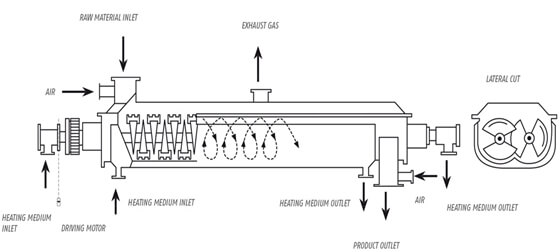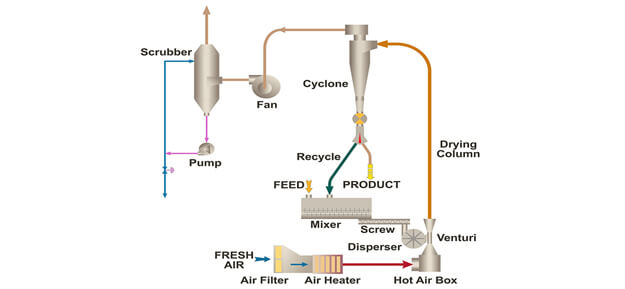footer
Home ©
Reva. All Rights Reserved.
There are many ways to dry products, but two things are essential: enough heat to evaporate liquid and a means of removing the vapor. A direct dryer uses hot air flow for both functions. Usually a lot of heat is wasted in the exhaust – and a lot of dust is created and consequent foul smelling - requiring expensive equipment for removal. Solvent recovery can be a problem too. An indirect dryer avoids all these problems: air flows, where present at all, are negligible. Moreover, a fully enclosed operation enables the safe treatment of toxic, noxious and/or flammable products.
Contact us today to discuss your Dryer needs!
The Paddle Dryer is well known for its compact construction and the consequently small need of installation space. This results from the high heat transfer coefficient and heat efficiency. That is because it has many square meters of heat exchanging surface relative to the volume. Two hollow shafts with hollow paddles turn in opposite directions in the horizontal trough. The trough has an ω- (omega) shape that follows the contours of the paddles.
REVA's paddle dryers / coolers are well-known for their robust construction with accurate constant tolerances. REVA offers any solution that contributes to the reliability of your particular production process. The machines are manufactured with sophisticated, state-of-the-art welding procedures, according to FEM analysis, so they can withstand high temperatures, heavy duty products and corrosion. The machines are designed for a long, continuous lifecycle. Our quality is inspected and certified by leading certification bodies in the world.

Wide range of particle size and shapes such as fine particles, granules, pellet, flakes. Also available for the material with high moisture content, slurry, and high viscosity.
Flash drying is a drying technology in which surface moisture of suspended particle is rapidly removed by dispersing particulate solids in a heated stream of gas/air.
Wet material is dispersed into a stream of heated air (or gas) which conveys it through a drying duct. Using the heat from the airstream, the material dries as it is conveyed.
Product is separated using cyclones, and/or bag filters. Typically, cyclones are followed by scrubbers or bag filters for final cleaning of the exhaust gases to meet current emission requirements.
Sectors: Agrifood, chemical, mineral.
Material Type: Powders, cakes, granules, flakes, pastes, gels, and slurries can be processed. For slurries, pastes, or sticky materials, backmixing of the wet feed with a portion of
dry product to produce a suitable conditioned material is required.
